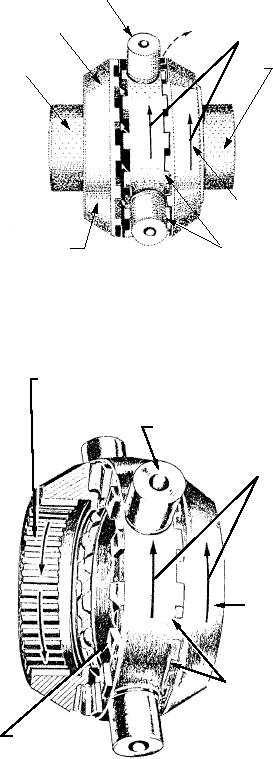
DRIVEN CLUTCH
no traction. The wheel on ice cannot spin because
SPIDER
MEMBER AND
RIGHT
SPIDER REMAIN
HAND
wheel speed is governed by the speed of the wheel
LOCKED AND
TURN
DRIVEN CLUTCH
TRAVEL AT
MEMBER
SAME SPEED
applying tractive effort. Therefore, the wheel on dry
pavement will pull to the limit of its tractional
SIDE
SIDE
MEMBER
MEMBER
resistance at the pavement.
MAINTENANCE
T h e g e a r o i l i n t h e d i ff e r e n t i a l s h o u l d b e
periodically checked and brought to the proper level if
needed. The area under the differential should be
DRIVEN CLUTCH
DRIVEN
MEMBER
CLUTCH
checked after the vehicle has been parked to determine
ELEVATED BY CAMS
MEMBER
DISENGAGES FROM
SPIDER CLUTCH TEETH
that the gaskets in the differential housing are not
AND TRAVELS AT
FASTER SPEED
SPIDER CLUTCH
leaking. When gaskets are leaking, you should drain
TEETH DRIVE DRIVEN
ASf02087
CLUTCH MEMBER
the gear oil, support the housing, remove the bolts and
old gasket, clean the surfaces, and install a new gasket.
When operating the vehicle in cold weather, the
Figure 2-87.--Operation of no-spin differential during
manufacturer's specifications should be consulted to
a turn.
determine the differential gear oil to be used. It may be
necessary to change gear oil with the seasons.
DRIVEN CLUTCH
MEMBER BECOMES
DISENGAGED AND
The first clue to existing trouble in a differential is
TRAVELS FASTER
THAN SPIDER
usually a noise. Defective universal joints, rough gear
SPIDER
SPIDER AND
DRIVEN CLUTCH
wheel bearings, or tire noises may be improperly
MEMBER TRAVEL
d i a g n o s e d a s d i ff e r e n t i a l t r o u b l e . To p r o p e r l y
AT SAME SPEED
determine the trouble, the source of the noise must be
found, and the operating conditions under which the
noise is most pronounced must be noted. A clue may be
gained as to the cause of the trouble by noting whether
the noise is a growl, a hum, or a knock; whether it is
heard when the vehicle is operating on a straight road,
DRIVEN
or on turns only; and whether the noise is most
CLUTCH
MEMBER
noticeable when the engine is driving the vehicle or
when it is coasting.
A humming noise in the differential usually means
DRIVEN CLUTCH
MEMBER TEETH
that the drive ring gear or drive pinion needs adjusting.
DRIVEN BY SPIDER
An improperly adjusted ring gear or pinion prevents
CENTER
normal tooth contact between the gears and produces
CAM MEMBER
gear noise and wear. The humming noise gradually
takes on a growling characteristic if the trouble is not
CENTER CAMS SERVE AS RAMPS TO ELEVATE
THE DRIVEN CLUTCH MEMBERS THROUGH
corrected, and the ring gear and pinion eventually need
ASf02088
CONTACT WITH THEIR FIXED CAMS
replacing. The manufacturer's specifications and
Figure 2-88.--Action of a center cam during a turn.
instructions should be consulted, studied, and followed
both. For a left turn, the action is similar except that full
for any adjustment.
drive is applied to the left wheel; the right wheel turns
Tire noises may be mistaken for differential
more rapidly than the left wheel.
noises. Tire noises vary according to the type of
With the no-spin differential, one wheel cannot
pavement the tires are on while differential noise will
spin because of loss of traction, and thereby deprives
not. To determine whether the noise is caused by tire or
the other wheel of its driving effort. For example,
differential, drive the vehicle over several types of
suppose that one wheel is on ice and the other wheel is
pavement, and if the noise changes with the type of
pavement, tires are the cause.
on dry pavement. The wheel on ice is assumed to have
2-74

